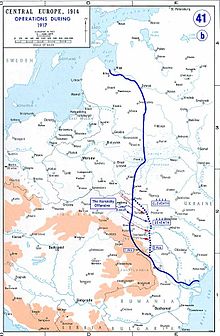Vilnius Conference
While the Conference laid the basic guiding principles of Lithuanian independence, it deferred any matters of the political structure of future Lithuania to the Constituent Assembly, which would later be elected in a democratic manner.
A Lithuanian independence movement arose during the 19th century,[5] based on concepts of national self-determination that were formalized in Woodrow Wilson's Fourteen Points speech in January 1918.
An openly pursued goal of annexation gave way to a more guarded policy after Germany perceived that a public relations backlash might occur: the Central Powers realized that the Allies could use such territorial expansion in their propaganda.
[8] The military administration approached a number of prominent members of the Lithuanian community, including Bishop Pranciškus Karevičius, Antanas Smetona, and Jonas Basanavičius, all of whom refused to participate in their rubber stamp advisory council.
[9] At the start of the meeting, the military authorities presented an ultimatum that any future conferences would need to declare loyalty to Germany and agree to annexation.
[8][9] Since no elections had been held the representatives had to be invited by the Organizing Committee, which included Mykolas Biržiška, Petras Klimas, Antanas Smetona, Jonas Stankevičius, and Jurgis Šaulys.
[9] A number of speeches were delivered during the early sessions of the council that denounced the German occupation, mentioning forced labor, heavy requisitions, and rampant deforestation.
[4] In response to various schemes to re-create the old Grand Duchy of Lithuania or Polish–Lithuanian Commonwealth, the new state was to be created only in the lands, that were assumed to be ethnically Lithuanian.
[10] In later years national minorities were granted the same rights as Lithuanians and in some cases extra representation in the government: after the war ended, the Council of Lithuania was expanded to include Jewish and Belarusian representatives;[11] the first governments of Lithuania included Ministries for Jewish and Belarusian affairs;[12] in 1920 the Jewish community was granted national and cultural autonomy with the right to legislate binding ordinances;[13] the Russian Orthodox Church received financial support from the government;[13] Germans, concentrated in the disputed Klaipėda Region, were also granted autonomy.


